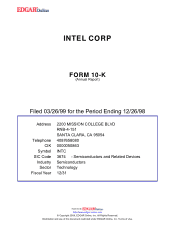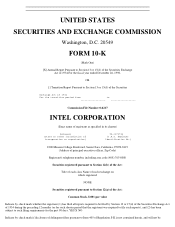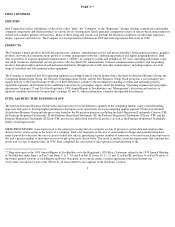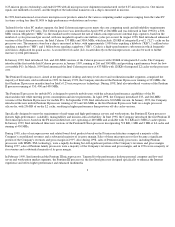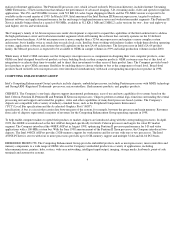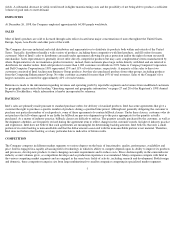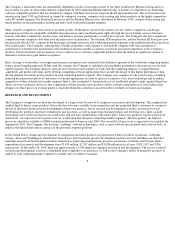Intel 1998 Annual Report Download - page 4
Download and view the complete annual report
Please find page 4 of the 1998 Intel annual report below. You can navigate through the pages in the report by either clicking on the pages listed below, or by using the keyword search tool below to find specific information within the annual report.
PART I **
ITEM 1. BUSINESS
INDUSTRY
Intel Corporation and its subsidiaries (collectively called "Intel," the "Company" or the "Registrant") design, develop, manufacture and market
computer components and related products at various levels of integration. Intel's principal components consist of silicon-
based semiconductors
etched with complex patterns of transistors. Many of these integrated circuits can perform the functions of millions of individual transistors,
diodes, capacitors and resistors. The Company was incorporated in California in 1968 and reincorporated in Delaware in 1989.
PRODUCTS
The Company's major products include microprocessors, chipsets, embedded processors and microcontrollers, flash memory products, graphics
products, network and communications products, systems management software, conferencing products and digital imaging products. Intel
sells its products to original equipment manufacturers ("OEMs") of computer systems and peripherals; PC users (including individuals, large
and small businesses and Internet service providers) who buy Intel's PC enhancements, business communications products and networking
products through resellers and retail and industrial distributors throughout the world; and other manufacturers, including makers of a wide
range of industrial and telecommunications equipment.
The Company is organized into four operating segments according to Intel's various product lines: the Intel Architecture Business Group, the
Computing Enhancement Group, the Network Communications Group, and the New Business Group. Each group has a vice president who
reports directly to the Chief Executive Officer of Intel. Reference is made to the information regarding revenues and operating profit by
reportable segments, and revenues from unaffiliated customers by geographic region, under the headings "Operating segment and geographic
information" on pages 27 and 28 of the Registrant's 1998 Annual Report to Stockholders and "Management's discussion and analysis of
financial condition and results of operations" on pages 30 and 31, which information is hereby incorporated by reference.
INTEL ARCHITECTURE BUSINESS GROUP
The Intel Architecture Business Group tailors microprocessors for the different segments of the computing market, using a tiered branding
approach, and seeks to develop higher performance microprocessors specifically for each computing market segment. Products in the Intel
Architecture Business Group include processors based on the P6 microarchitecture (including the Intel -Registered Trademark- Celeron -TM-,
the Pentium -Registered Trademark- II, the Pentium -Registered Trademark- III, the Pentium -Registered Trademark- II Xeon -TM- and the
Pentium -Registered Trademark- III Xeon -TM- processors) and related board-level products as well as the Pentium -Registered Trademark-
family of microprocessors.
MICROPROCESSORS. A microprocessor is the central processing unit of a computer system. It processes system data and controls other
devices in the system, acting as the brains of a computer. Intel's developments in the area of semiconductor design and manufacturing have
made it possible to decrease the size of circuits etched into silicon, permitting a greater number of transistors to be used on each microprocessor
die, and a greater number of microprocessors to be placed on each silicon wafer. The result is smaller, faster microprocessors that consume less
power and cost less to manufacture. In 1998, Intel completed the conversion of microprocessor manufacturing to the
** Page references to the 1998 Annual Report to Stockholders or to the Registrant's 1999 Proxy Statement related to the 1999 Annual Meeting
of Stockholders under Item 1 in Part I and Items 5, 6, 7, 7A and 8 in Part II; Items 10, 11, 12 and 13 in Part III; and Item 14 in Part IV relate to
the bound, printed versions of such Report and Proxy Statement, not to the electronic versions appearing at the Intel Internet site
(www.intel.com and www.intc.com). However, all data referred to also appears in the electronic versions.
2

